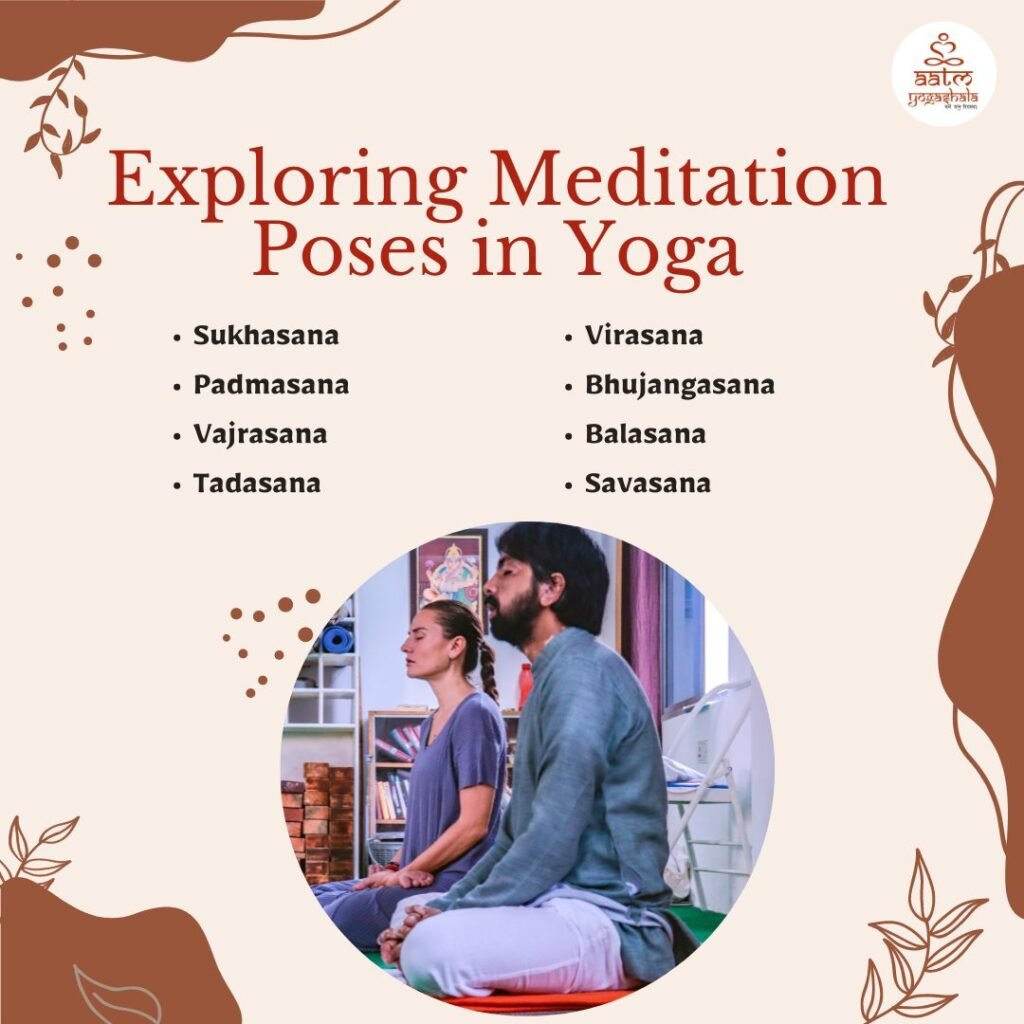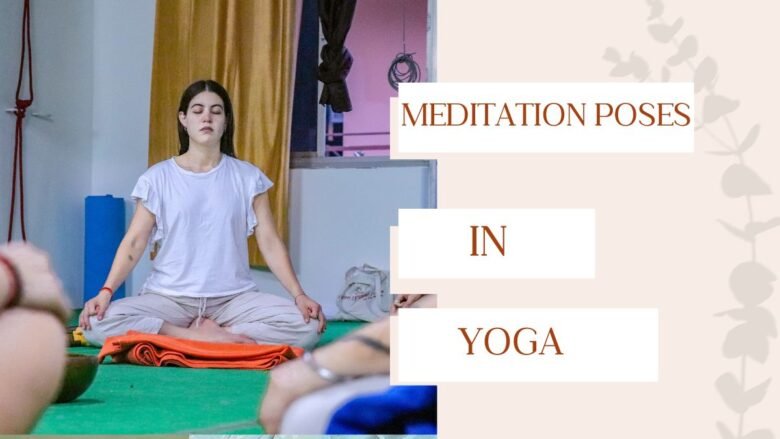“Discover calming yoga poses for meditation at Aatmyogashala! Learn easy-to-follow techniques for inner peace and relaxation. Join our yoga school and explore the world of meditation poses today!”
In today’s busy world, finding quiet moments is really important for our health. Meditation and yoga are old ways to help us feel peaceful inside. Yoga uses different poses to make our bodies strong and get our minds ready for quiet thinking. The way you sit or stand for meditation really matters.
We’re going to look at different yoga poses and see how they help us meditate better. We’ll learn how they work and how they can make us feel better. This guide will help you feel more at peace inside.
Understanding Meditation Positions
Before we settle into the “how” of meditation poses in yoga, it’s important to understand the “why.” The positions, also known as asanas, aren’t arbitrary specifications but are chosen for their ability to promote a state of mental clarity and physiological balance.
When you assume these postures, energy channels in the body, known as nadis, are believed to open, allowing the free flow of prana, or life force. This alignment, both of body and breath, clears the way for a clearer, more unobstructed path towards the meditative state.
Exploring Yoga and Meditation
Meditation and yoga are closely linked. Yoga unites mind, body, and soul, and prepares the body for deeper meditation. Together, they offer more benefits than alone, enhancing both physical and spiritual well-being.
10 Yoga Poses to Practice Before Meditation


1. Sukhasana (Easy Pose)
Benefits:
Sukhasana calms the brain, strengthens the back, and stretches the knees and ankles. It provides a stable position for prolonged meditation.
How to do it:
Begin by sitting cross-legged on the floor, hands on knees, spine straight, and shoulders relaxed. Ensure each foot is beneath the opposite knee. Breathe deeply and focus on your breath to enter a meditative state.
2. Padmasana (Lotus Pose)
Benefits:
Padmasana creates a sense of stability and calm. It stretches the ankles and knees while improving posture and promoting circulation in the lumbar spine.
How to do it:
Sit on the floor. Place your right foot on your left thigh and your left foot on your right thigh. Keep the spine aligned and place hands on knees in a mudra of your choice. Maintain the pose and focus on breathing deeply.
3. Vajrasana (Diamond Pose)
Benefits:
This pose aids digestion and can be performed even after meals. It helps strengthen the thigh muscles and promotes a state of mindfulness and concentration.
How to do it:
Kneel on the floor, bringing your buttocks to rest on your heels. Keep the spine straight and hands on your thighs. Close your eyes to meditate, maintaining the position as long as comfortable.
4. Tadasana (Mountain Pose)
Benefits:
Tadasana improves posture, strengthens thighs, knees, and ankles, and helps to focus the mind.
How to do it:
Stand with feet together, arms by the side. Firm your thigh muscles and lift the knee caps, but don’t harden the lower belly. Imagine a line of energy passing through your body, grounding you down and extending you up.
“Meditation is not adopting a certain posture; it’s about finding your own pose within.” – Aatm Yogashala
5. Virasana (Hero Pose)
Benefits:
Virasana helps improve posture, stretches the thighs and ankles, and helps relieve leg fatigue, making it easier to sit in meditation for longer periods.
How to do it:
Kneel on the floor with knees together and buttocks resting on the heels. Keep the spine straight and hands on the thighs. Focus on your breathing.
6. Bhujangasana (Cobra Pose)
Benefits:
Bhujangasana increases spinal flexibility, tones the abdominal muscles, and opens the heart, facilitating deeper breathing for meditation.
How to do it:
Lie on your stomach with hands under shoulders, elbows close to your body. Press into the floor with your hands, lifting the chest up. Keep the elbows slightly bent and shoulders down.
7. Balasana (Child’s Pose)
Benefits:
Balasana releases tension in the back, shoulders, and chest, promoting stress relief and a deeper sense of peace.
How to do it:
From a kneeling position, touch your big toes together, sit on your heels, and spread your knees as wide as your hips. Lay your torso between your thighs and extend your arms forward.
Also Read:Best 200 hour yoga teacher training School
8. Savasana (Corpse Pose)
Benefits:
Savasana helps to relieve stress and promote a meditative state by allowing the body to relax deeply in a non-active state.
How to do it:
Lie flat on your back with arms at your sides, palms up, and feet spread slightly apart. Close your eyes and breathe naturally, allowing your body to feel heavy and relaxed.
9. Ardha Matsyendrasana (Half Lord of the Fishes Pose)
Benefits:
This pose increases spinal flexibility and stimulates the digestive fire, preparing the body and mind for meditation.
How to do it:
Sit with legs extended. Bend the right knee, placing the right foot on the outside of the left knee. Twist your torso to the right, placing your left elbow on the outside of the right knee. Keep the spine long and the shoulders relaxed.
10. Ananda Balasana (Happy Baby Pose)
Benefits:
Ananda Balasana releases tension in the back, soothes the mind, and brings a sense of joy and ease, great for preparing the mind for meditation.
How to do it:
Lie on your back, exhale, and bend your knees into your belly. Grip the outside edges of your feet with your hands, and open your knees slightly wider than your torso. Bring your knees towards your armpits, keeping the ankles directly over the knees.
Yoga poses help you focus, relax, and meditate better.
Tips for Getting Started with Yoga Meditation
Starting your yoga meditation practice can feel daunting, but it doesn’t have to be. Here are some simple tips to help you begin:
- Start Slow: Don’t rush. Begin with short sessions and simple poses.
- Be Consistent: Try to meditate at the same time each day to build a routine.
- Focus on Breathing: Pay attention to your breath—it’s key for relaxation and focus.
- Don’t Stress: It’s okay if your mind wanders or you’re not perfect in a pose.
- Create a Quiet Space: Find a calm spot where you can practice without interruptions.
- Listen to Your Body: If something hurts, stop. Yoga shouldn’t cause pain.
- Enjoy the Process: The goal is peace and understanding, not perfection.
How long should I stay in each yoga pose for meditation?
The duration of each pose can vary depending on your level of comfort and experience. For beginner yogis, even 1-3 minutes in a single position can pave the way for an enriching meditation practice. For more seasoned practitioners, 5-10 minutes or until you feel fully at ease and grounded.
The key with any meditative pose is not to impose a rigid timeline but to listen to your body and adjust as necessary for your individual progress.
Addressing Common Challenges
Yoga and meditation are unique to each person, and it’s okay to face challenges along the way. If you feel physical discomfort, try using yoga blocks or other props and take it slow. If your mind keeps wandering during meditation, gently bring your focus back without getting frustrated. Making yoga and meditation part of your daily routine can help manage daily stress.
How to Sit Comfortably While Meditating
Whether it’s a simple cross-legged pose, the revered lotus position, or any other that you choose, comfort is of the essence. To achieve this, here are some tips to set you on the right path:
- Begin by ensuring your spine is straight, but not rigid. Visualize a straight line extending from the base of your spine to the crown of your head.
- Adjust your hips as necessary to find balance over your sit bones, supporting the natural curve of your lower back.
- Relax your shoulders away from your ears, allowing your chest to open and for breath to flow freely.
- Your gaze can be soft, or you may choose to close your eyes. Whichever you opt for, the goal is to minimize visual distractions.
- Ground your position by pressing into the earth or surface you’re sitting on. This grounding is not only physical but symbolic, fostering a connection with the earth and a grounded mindset.
Conclusion
In this comprehensive examination of meditation poses in yoga, the intention is clear: to assist you in realizing the powerful synthesis of these ancient practices. Whether you’re at the beginning of your mindful journey or seeking to deepen an existing practice, the gateway to serenity lies within each asana. By understanding and embodying the postures here, you take a conscious step towards inner peace and a life more harmonious with the present moment.
FAQ for Meditation Poses in Yoga
What is the best time to practice yoga poses for meditation?
The ideal time for practice is influenced by several factors, including personal preference and schedule. Traditionally, early mornings are recommended as it’s believed the mind is quieter. However, consistency in practice is more important than the specific time of day.
Can I practice meditation without doing yoga?
Absolutely. While yoga can offer a seamless transition into the meditative state, meditation can also be practiced independently. You can meditate in any comfortable position that allows you to breathe and focus effectively, even if it’s just for a few moments in the middle of a busy day.
Are there any yoga poses that are not appropriate for meditation?
Most yoga poses can be adapted to aid in the meditation practice. However, extremely dynamic or vigorous sequences are less suited for immediate transition to stillness. It’s advisable to incorporate a more restful end to your yoga practice before moving into meditation.
How can I enhance the connection between my yoga practice and meditation?
Using a consistent breath pattern in yoga and carrying it into meditation can strengthen the link between the two practices. Additionally, the intention set at the beginning of your yoga practice can be carried through to your meditation, keeping focus and purpose aligned.




